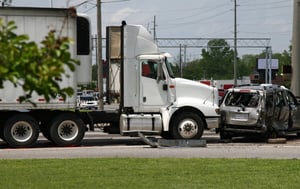Rear-end crashes typically result in severe losses and can be catastrophic for everyone involved. Preventing rear-end crashes requires drivers to recognize the hazards that increase the odds of a crash, know the defense, and to react properly. Read the information below, and ask yourself how you can improve your vigilance and driving style.
RECOGNIZE THE HAZARDS
 ENVIRONMENT
ENVIRONMENT
Both wet and dry road conditions can affect traction and the vehicle’s stopping distance. Likewise, sun glare, fog, and other environmental factors can be distracting and reduce visibility, thus affecting perception and reaction times.
 EQUIPMENT
EQUIPMENT
Insufficient tread depth on tires or out-of-adjustment brakes can reduce a driver’s ability to stop the truck safely. An empty or lightly-laden trailer may make stopping a tractor-trailer more difficult.
 PERSONAL BEHAVIORS
PERSONAL BEHAVIORS
Distracted driving, speeding, driving too fast for conditions, and tailgating are unsafe driving behaviors that increase the risk of a rear-end crash. Driving while ill, fatigued, or under the influence of alcohol or drugs can also affect one’s ability to perceive hazards and react in time.
KNOW THE DEFENSE
 VEHICLE INSPECTIONS
VEHICLE INSPECTIONS
Check tires for sufficient tread depth and ensure brakes are properly adjusted. If hauling an empty or lightly-laden trailer, factor the lack of trailer weight into your following distance so you can stop the truck in time.
 AVOID DISTRACTIONS
AVOID DISTRACTIONS
Focus on the task of driving, and avoid distractions inside and outside the cab. Talking or texting on the phone and eating or drinking while driving divert your attention away from hazards in front of you.
 OBSERVE PROPER SPEED FOR CONDITIONS
OBSERVE PROPER SPEED FOR CONDITIONS
Reduce speed by at least 2-3 mph below the flow of traffic, not to exceed the posted speed limit. Adjust your speed based on the hazards present, including construction and school zones.
 MAINTAIN PROPER FOLLOWING DISTANCE
MAINTAIN PROPER FOLLOWING DISTANCE
Keep a minimum of six seconds behind the vehicle in front, and add at least one second more for each additional hazard present, like rain, sun glare, or traffic congestion.
 BE ATTENTIVE TO THE ROAD AHEAD
BE ATTENTIVE TO THE ROAD AHEAD
Watch for traffic slowing or stopping ahead, then get off the accelerator and apply controlled braking. Perceiving hazards sooner allows more time to react.
 REACT PROPERLY TO HAZARDS
REACT PROPERLY TO HAZARDS
When traffic ahead stops, try to stay in one lane and avoid abrupt lane changes. If you feel fatigued or distracted, pull over and rest or resolve any issues so you can return your focus to driving.
Note: These lists are not intended to be all-inclusive.
This material is intended to be a broad overview of the subject matter and is provided for informational purposes only. Joe Morten & Son, Inc. does not provide legal advice to its insureds or other parties, nor does it advise insureds or other parties on employment-related issues, therefore the subject matter is not intended to serve as legal or employment advice for any issue(s) that may arise in the operations of its insureds or other parties. Legal advice should always be sought from legal counsel. Joe Morten & Son, Inc. shall have neither liability nor responsibility to any person or entity with respect to any loss, action, or inaction alleged to be caused directly or indirectly as a result of the information contained herein. Reprinted with permission from Great West Casualty Company.


